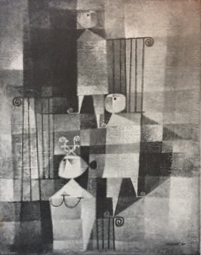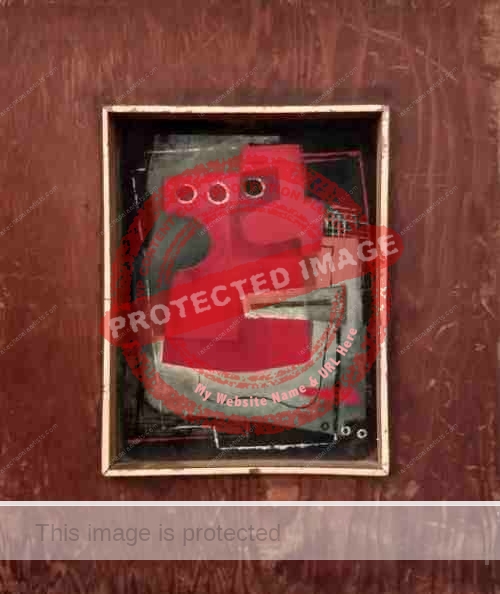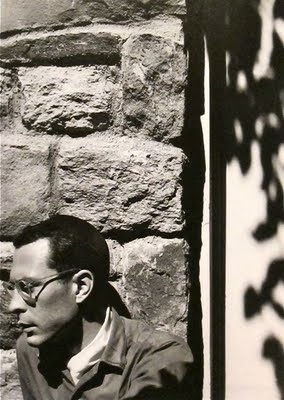Alexander Nicolas (“Nick”) Muzenic was born 25 September 1919 in Kansas, and died in Los Angeles 12 March 1976. His first names are variously listed as Nicolas, Nicholas, Nikolas, A. Nicolas or simply Nick. His family, of Austro-Croatian heritage, also used the anglicized surname Muzenich.
He lived and worked in Ajijic from about 1948 to 1953.
Muzenic graduated from the University of Kansas at the age of 19 before studying on a scholarship at the Art Center School of Los Angeles. After serving in the US Naval Intelligence Service for a year, from 22 June 1944 to 23 May 1945, he continued his art education at Black Mountain College.
Black Mountain College was a liberal arts college in North Carolina; its faculty members at one time or another included such luminaries as Josef Albers and Anni Albers, John Cage, Merce Cunningham, Buckminster Fuller and Aaron Siskind.
This portrait of him, in his time at Black Mountain College, was taken by Hazel Larsen Archer, a fellow student. American sculptor Ruth Asawa, famous for her intricate and mesmerizing wire baskets and wire bushes, was also one of Muzenic’s fellow students. Asawa studied Spanish and art in Mexico City in 1945 and first encountered the technique of crocheting wire in Toluca in 1947. She may have influenced Muzenic in his decision to move to Mexico. Muzenic and Asawa both gifted books on Mexican art to the Black Mountain College library.
In November 1946, one of Muzenic’s paintings, “Introspection”, was included in an exhibit for a Children’s Fair at New York’s Museum of Modern Art (MOMA).
After college, Muzenic’s first solo exhibition was at the American British Art Center in New York. This show, which opened on 6 January 1948, featured at least 24 works; the introduction to the catalog was written by Anni Albers. Later that year, the same collection was hung in Chicago. According to The New Yorker, this was “A first one-man show of abstractions that indicate a perceptive sense of color and pattern.”
We know more about Muzenic’s next few years, when he moved to Mexico and lived in Ajijic for at several years from about 1948 to 1953. During that time, he was employed—along with Tobias Schneebaum and Ernesto Butterlin—by Irma Jonas to teach students attending her summer painting schools in Ajijic.
According to Schneebaum, an ill-fated love triangle developed between the three artists at this time, complicated by the arrival of “haughty and radiantly beautiful” Zoe Kernick, the “fourth member of our group”, who had previously been living with Henry Miller in Big Sur.

Nicolas Muzenic. ca 1953. Escalera.
Schneebaum, who shared a house with Muzenic for part of his time in Ajijic, described Muzenic as tall, “cold, haughty and grand.” As for his paintings, “Nicolas’s paintings were as tight, involuted and hard-edged as his body, and were somber with browns and dirtied yellows, unlike the clarity, brilliance and simplicity of his teacher.” (Schneebaum, Wild Man 13).
The teacher Schneebaum is referring to is Josef Albers. In his Secret Places, Schneebaum recalls that Muzenic “had been a student of Josef Albers at Black Mountain College. Albers himself arrived one afternoon, accompanied by his wife, Anni. They spent a couple of nights in Ajijic.” (Secret Places, 7)
According to Schneebaum, Ernesto Butterlin (aka Lin) and Muzenic had “a frenzied, volcanic affair that lasted two years.” “Lynn’s casual ways bewitched and irritated Nicolas, just as Nicolas’s arrogant, snobbish manner attracted and mortified Lynn. Nicolas moved into Lynn’s house.” Muzenic eventually bought the property and forced Lynn to move out. (Wild Man 13)

Nicolas Muzenic. Red Forms. Date unknown. Photo courtesy of Bill Sinyard.
Muzenic’s work was included in two group shows in 1949. The first, in March at the State Museum in Guadalajara featured works by the four artists of the “Ajijic group” (Muzenic, Louise Gauthiers, Ernesto Linares and Tobias Schneebaum), along with works by Guadalajara-based abstract-surrealist artist, Alfredo Navarro España. The second exhibit—at the Villa Montecarlo in August 1949, and billed as the 4th Annual Painting Exhibition—showcased works by Muzenic, Tobias Schneebaum, Alfredo Navarro España, Shirley Wurtzel, Ann Woolfolk and Mel Schuler.
Muzenic’s work found its way into some very significant private collections. For instance, when a small selection of the Fred Olson Collection was shown at the Artists Guild in St. Louis, Missouri, in March 1952, Muzenic’s work was hung alongside works by Picasso, Klee, Albers and other internationally renowned artists.
In 1953, Muzenic held a solo exhibition which opened on 23 September and closed on 16 October at the Galería San Ángel (Dr. Gálvez 25), in the southern part of Mexico City. The small printed program of that exhibit included an introduction by Anni Albers praising the artist’s use of form, color and composition. Among the 18 paintings and 6 constructions in the show was “Valentine para Zoe,” lent by Zoe Kernick. Other works had been lent by Margaret Mason, Rémy Bastien and Berenice Cortelle. Mason, Muzenic’s sister, and her husband, Kenneth Mason (the basis for the character Lawrence Creighton in Eileen Bassing’s novel Where’s Annie?), were both living in Ajijic at the time.
The constructions, “created with simple materials such as string, colored lacquer and nails on small black panels” were especially admired by Carlos Merida, who remarked “it is astonishing to consider the limited elements which have sufficed the artist to instill life into these beautiful architectural structures, windows into cosmic worlds.”
Muzenic had his fourth solo show at the Santa Barbara Museum in November 1953. By this time examples of his paintings were already in various prestigious private collections, including those of Fred Olsen, Henry P. McIlhenny, Joseph Pulitzer Jr., and Mrs Huttleston Rogers. A review of this show was illustrated by “Posada” which had previously been displayed in Mexico City.
While living in Ajijic, Muzenic became a close friend of Eileen and Bob Bassing. After the Bassings returned to California and one of Eileen’s novels was turned into a screenplay, they used the resulting windfall to commission Muzenic to design them a home on Carbon Beach, Malibu, a home later featured on the cover of Time magazine.
Muzenic was also living in California by that time, and working mainly as an interior designer. His employer for many years was the Welton-Beckett architectural firm in Los Angeles. Schneebaum says that Muzenic “lived alone in Los Angeles, rich, isolated, and introspective.” (Wild Man, 18). In 1976, only a few days after losing his job, he died in his own home.
Note: this is an updated version (November 2023) of a post first published 8 January 2015.
Sources:
- Bob Bassing, personal communication, January 2023.
- Galería San Ángel. 1953 Catalog for Muzenic exhibit, 1953.
- Tobias Schneebaum. 1979. Wild Man.
- Tobias Schneebaum. 2000. Secret places: my life in New York and New Guinea.
- Henry J Seldis. 1953. “Muzenic Show Reveals Skill in Decorative Art Field.” Santa Barbara News Press, 22 November 1953.
Several chapters of Foreign Footprints in Ajijic: Decades of Change in a Mexican Village offer more details about the history of the artistic community in Ajijic.
Comments, corrections or additional material related to any of the writers and artists featured in our series of mini-bios are welcomed. Please use the comments feature at the bottom of individual posts, or email us.
Tony Burton’s books include “Lake Chapala: A Postcard History” (2022), “Foreign Footprints in Ajijic” (2022), “If Walls Could Talk: Chapala’s historic buildings and their former occupants” (2020), (available in translation as “Si Las Paredes Hablaran”), “Mexican Kaleidoscope” (2016), and “Lake Chapala Through the Ages” (2008).
